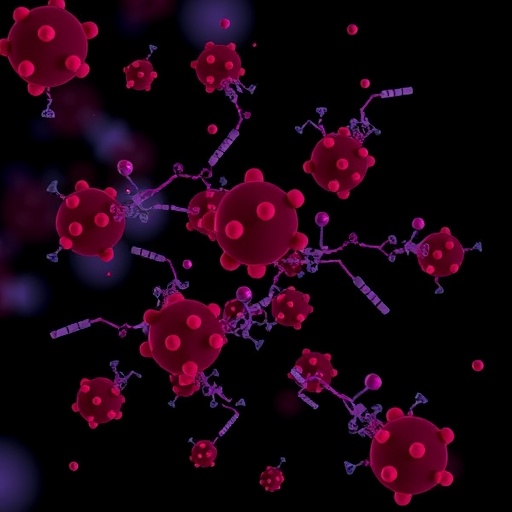In a groundbreaking study published in BMC Psychiatry, researchers have illuminated the complex interplay between inflammatory markers and acute schizophrenia symptoms, offering promising insights into the biological underpinnings of this enigmatic psychiatric disorder. The investigation focused on serum levels of key cytokines—tumor necrosis factor-alpha (TNF-α), interleukin-8 (IL-8), and interleukin-18 (IL-18)—and their correlation to clinical manifestations experienced by medication-free patients during an acute phase of schizophrenia. This exploration is pivotal in bridging the gap between immune system dysregulation and psychiatric symptomatology.
Schizophrenia has long been considered a multifaceted neuropsychiatric disorder with elusive etiology. Emerging evidence suggests that inflammatory mechanisms may significantly contribute to its pathophysiology. However, the precise relationship between specific cytokines and the clinical expression of symptoms, particularly in acute phases, remains incompletely understood. The authors tackled this challenge by enrolling a cohort of 71 acute schizophrenia patients who had abstained from medication for at least four weeks, alongside 55 healthy controls, enabling a direct comparison of inflammatory marker profiles untainted by pharmacological effects.
Employing advanced Luminex liquid suspension chip assays, the study quantitatively measured serum concentrations of TNF-α, IL-8, and IL-18. These cytokines were selected for their established roles in modulating immune responses and neuroinflammation. Notably, TNF-α and IL-8 are prominent pro-inflammatory mediators implicated in systemic and central nervous system immune activation, while IL-18 exhibits complex regulatory functions, often associated with both inflammatory and metabolic pathways.
The results revealed a striking dysregulation of cytokine levels in acute schizophrenia. Patients exhibited significantly elevated serum TNF-α and IL-8 compared to controls, underscoring an amplified inflammatory state. Conversely, IL-18 levels were markedly reduced, suggesting a nuanced immunological signature rather than a generalized immune activation. This differential pattern hints at distinct roles for each cytokine in the neuroimmune landscape of schizophrenia, potentially influencing diverse symptom clusters and disease trajectories.
Crucially, the study delineated the relationship between these cytokines and clinical symptom dimensions derived from the five-factor Positive and Negative Syndrome Scale (PANSS). After rigorous adjustment for potential confounders, higher serum levels of TNF-α and IL-8 were positively associated with the anxiety/depression factor on PANSS. This finding aligns with mounting research linking neuroinflammation to mood dysregulation and anxiety symptoms, which frequently co-occur with schizophrenia exacerbations yet are often overlooked in therapeutic paradigms.
Further statistical analyses revealed intercorrelations among the cytokines themselves. TNF-α showed significant positive associations with both IL-8 and IL-18, reflecting interconnected inflammatory pathways that may collectively modulate disease expression. Interestingly, IL-18’s positive correlation with body mass index and sex underscores the influence of metabolic and demographic variables on immune parameters, potentially indicating a link between systemic physiology and neuropsychiatric symptomatology.
Age of schizophrenia onset and excitement/hostility symptoms also displayed noteworthy associations, specifically with the excitement/hostility factor correlating positively with earlier disease onset. This suggests that inflammatory profiles might exhibit clinical specificity not only in symptom dimensions but also in relation to disease chronology, offering a multifaceted perspective on schizophrenia heterogeneity.
Sex differences, a crucial yet complex variable in psychiatric research, were interrogated but did not appear to modulate the relationship between IL-8 levels and anxiety/depression symptoms, indicating that this particular immunopsychiatric link transcends biological sex distinctions within the cohort examined. Such insights emphasize the universality of certain immune-related symptom associations and could inform personalized treatment approaches.
The implications of these findings are profound, suggesting that targeted modulation of inflammatory cytokines could serve as a biomarker-driven adjunct to conventional therapeutic strategies. By elucidating the role of TNF-α and IL-8 in anxiety and depressive symptomatology during acute psychotic episodes, the study advocates for integrated interventions that address both neuroinflammatory and psychiatric dimensions simultaneously.
Moreover, this research dovetails with a growing movement toward precision psychiatry, where biological markers guide diagnosis, prognosis, and treatment. Understanding the immunological milieu of schizophrenia not only deconstructs its pathophysiology but also paves the way for novel anti-inflammatory treatments that could ameliorate symptom burden and improve functional outcomes. The cross-sectional nature of the study marks an essential step, though longitudinal research is warranted to capture dynamic cytokine fluctuations over disease course and therapeutic response.
This study’s meticulous methodology, including medication-free participant selection and employing state-of-the-art cytokine quantification technologies, strengthens the validity of the findings. It accentuates the necessity of immune profiling in psychiatric populations to decipher the intricate dialogue between peripheral inflammation and central nervous disturbances inherent to schizophrenia.
As the scientific community seeks to unravel the mysteries of schizophrenia, the confirmation of inflammatory involvement shifts paradigms previously dominated by neurotransmitter-centric models. Incorporating immune dysregulation into conceptual frameworks reframes schizophrenia as a systemic disorder with neuroimmune interdependencies, potentially revolutionizing clinical management strategies.
Future explorations should aim to validate these findings in larger, diverse populations and investigate causality through experimental models. Additionally, probing the mechanistic pathways through which TNF-α and IL-8 contribute to neuropsychiatric symptom clusters will advance therapeutic discovery. Integrated omics approaches combining immunology, genomics, and neuroimaging could further elucidate the complex etiopathogenesis.
Ultimately, the study by Xu, Yang, Chen, and colleagues adds a significant piece to the schizophrenia puzzle, championing the critical role of inflammation in its acute manifestations. The observed cytokine alterations invite a reevaluation of diagnosis and intervention, steering psychiatry toward a more holistic, biologically informed future.
Subject of Research: Inflammatory cytokine profiles and their association with clinical symptoms in acute schizophrenia patients.
Article Title: Associations of serum TNF-α, IL-8, and IL-18 levels with the clinical symptoms in acute schizophrenia: a cross-sectional study.
Article References:
Xu, L., Yang, H., Chen, W. et al. Associations of serum TNF-α, IL-8, and IL-18 levels with the clinical symptoms in acute schizophrenia: a cross-sectional study. BMC Psychiatry 25, 1096 (2025). https://doi.org/10.1186/s12888-025-07549-x
Image Credits: AI Generated
DOI: 10.1186/s12888-025-07549-x (Published 18 November 2025)




